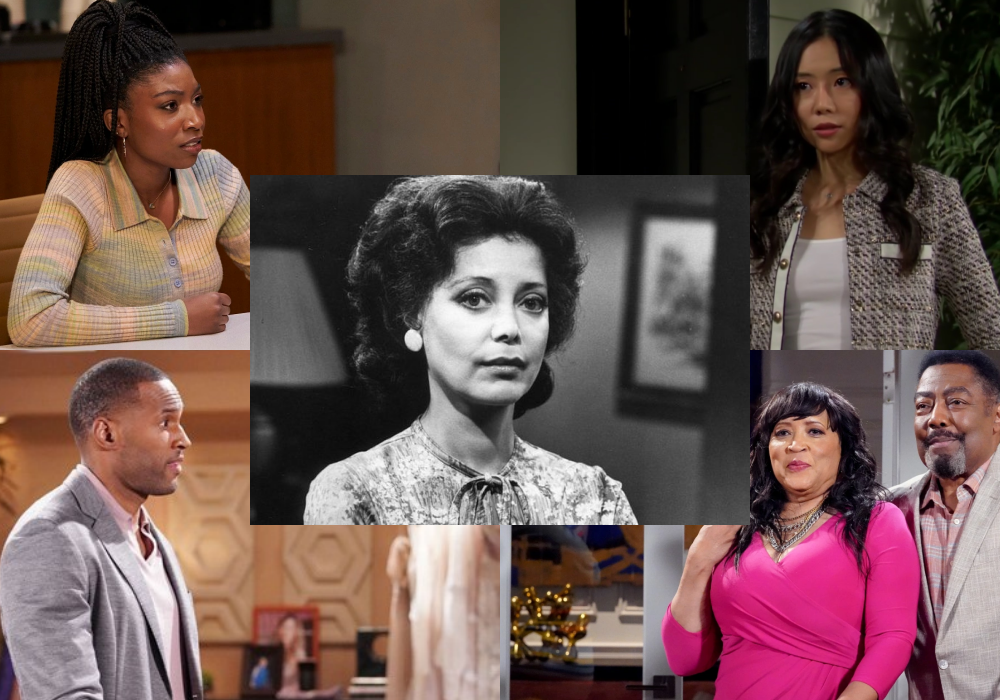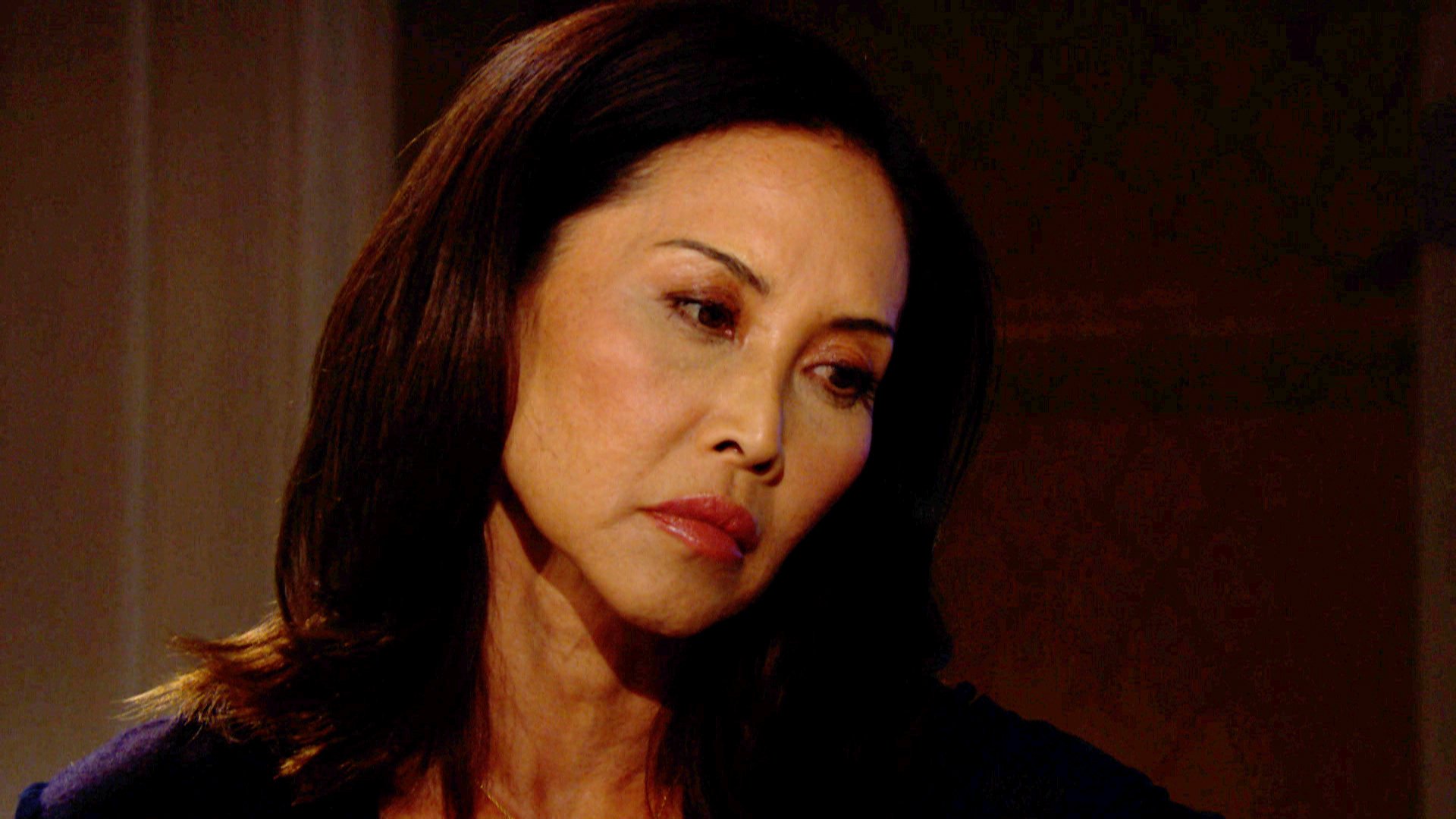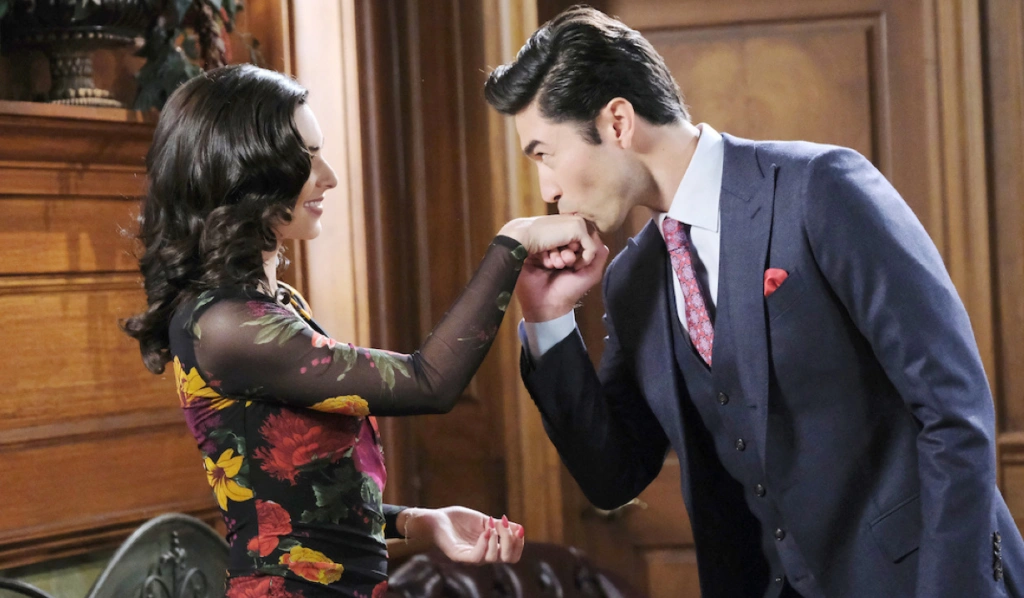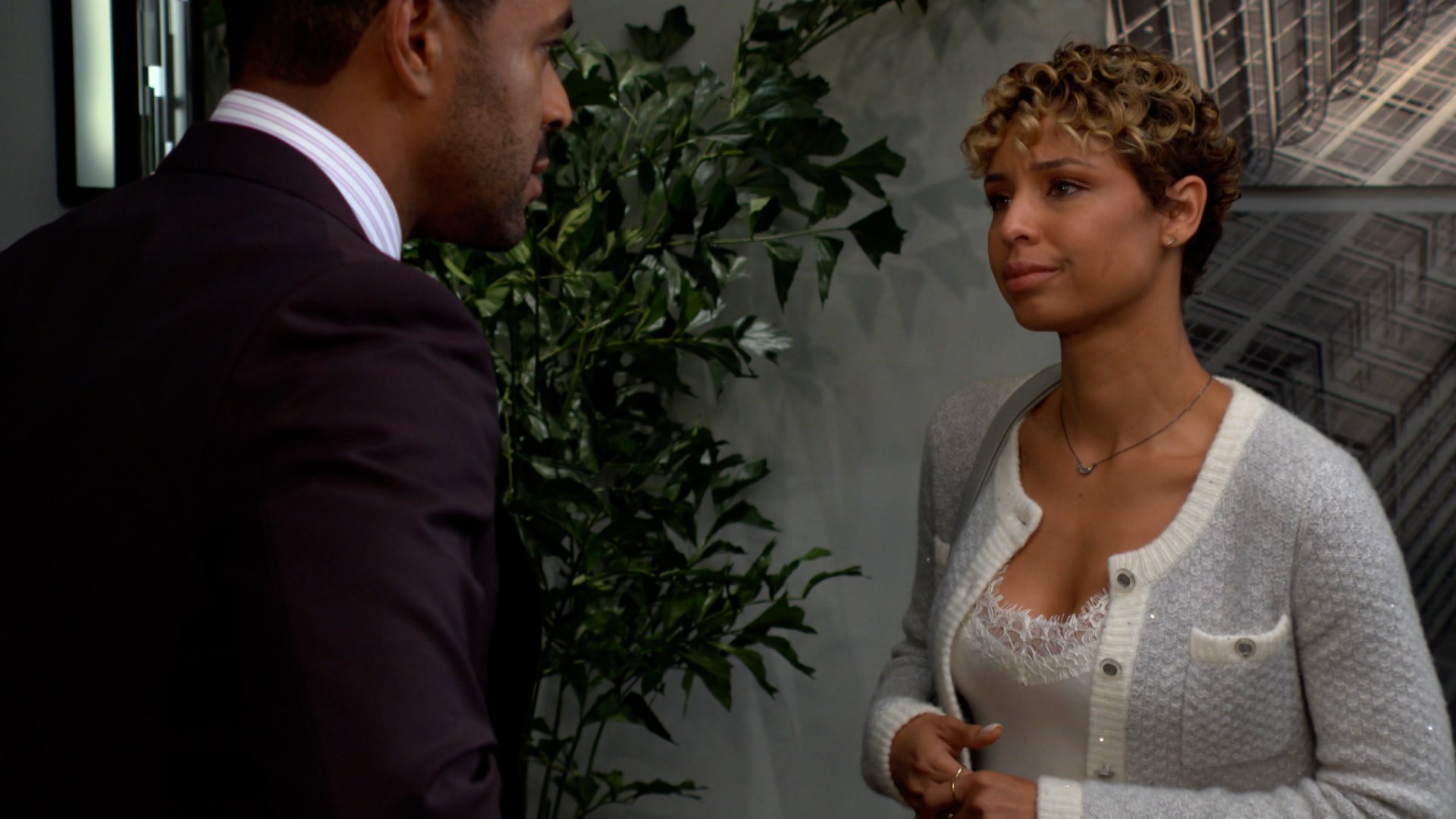The State Of Diversity On Daytime Dramas
Tabyana Ali - General Hospital/ABC (top left), Kelsey Wang - The Young and the restess/CBS/Sony (top right), Ellen Holly - One Life to Live/ABC (center), Lawerence St. Victor - The bold and the beautiful/cbs/Bell Phillip’s Productions, and Jackée Harry & james reynolds - days of our lives/Peacock/corday productions.
In the United States, the representation of people of color (POC) in media has always been a work in progress. In daytime drama television, POC have been historically underrepresented despite efforts from actors to establish greater diversity in the field. Daytime drama, or specifically soap operas, have been one of the steadiest and most influential forms of television since its formation. Familiarity with soap operas ranges from person to person. There are countless fans who have been continuously enthralled by the complex and interwoven storylines of this medium for years, while there are others who are only familiar with soaps from their parents’ television or from SNL’s “The Californians” skits. However, regardless of one’s connection to soap operas, these shows have been influential and integral to the development of television and American media. The legacy of this genre makes its historical underrepresentation of POC even more unfortunate, as the many decades of soap opera serialization has not been as inclusive as they should have been. Looking toward the future of soap operas, it is of utmost importance for diversity and inclusion to be the priority for these shows today.
To understand the range that is covered by daytime drama, it’s important to define what a soap opera is. Soap operas are long-running television serials that air in daytime slots with intricate plots and ensemble casts. These shows can run for decades at a time, with several actors staying on contract for a considerable number of years. The two main types of commitments for soap actors are contract and recurring: the former category holding consistent appearances on the show and the latter having some more unpredictability but still notable enough roles. When looking at POC representation in front of the screen, these are the two roles that are important to look at.
When soap operas were starting to rise in popularity in the 1960s, POC attempted to break through. In 1967’s Love Is A Many Splendored Thing, Nancy Hsueh starred as the first POC and Asian American & Pacific Islander (AAPI) lead on a soap opera, but her time was cut short due to negative reception towards her interracial relationship with a white character. Ellen Holly was the first African American lead in a soap when she starred on One Life to Live for 17 years starting in 1968. As a white-passing actress, the truth of her ethnicity wasn’t revealed until a later plot point in her tenure; a plot that was then met with surprise and backlash. In the decades following, soaps began to have a greater number of African American cast members, but they were typically limited to 3-4 contract players per show and were often written off by their second contract cycle. The efforts of these actors to increase the diversity on these shows were admirable and though they were not initially successful, they paved the way for later generations of POC actors to establish a stronger footing in the field.
Though there may not be as many soap operas on the air today, the last few are bastions of their genre that continue to build on their already great legacies with a continued devotion to their viewers. These shows are The Bold and the Beautiful, Days of Our Lives, General Hospital, and The Young and the Restless. To get an understanding of the state of diversity within a daytime drama, it is important to look at each of these big four soap operas to see what they have done to help improve inclusivity. Looking at the representation within their casts and production members will help illustrate what work needs to be done for greater representation in this television genre.
The Bold and The Beautiful
CBS/Bell Phillip’s Productions
The Bold and The Beautiful has been airing on CBS since 1987 and stands out from other soaps for its half-hour runtime, while others air in 1-hour time slots. The drama that unfolds in this series takes place in Los Angeles, California, one of the most diverse cities in the US. However, the cast does not necessarily reflect this accurately. Currently, the show has seventeen contract actors, of which only three are POC. POC makes up 22% of the contract and recurring players on the series. Looking at the production side, B&B has two scriptwriters of color. Of note is Lawrence Saint-Victor, who serves dual roles as a contract player and one of the writers behind the scenes. Saint-Victor undertook the dual responsibilities to help make the character writing of POC characters more authentic. Including a POC actor in the writer’s room is the result of growth in the field and is a legacy of other actors of color making steps to create more authentic characters. Victoria Rowell from The Young and The Restless, B&B’s sister show, was noted for adding her own spin on her character to make them more realistic to their ethnicity—something that is only made possible when POC can provide input on the writing of their narratives.
The Bold and The Beautiful Contract and Recurring Actors
Recurring:
Cassandra Creech
Dan Martin
Aaron D. Spears
Jeremy Ray Valdez
Contract:
Delon de Metz
Lawrence Saint-Victor
Diamond White
Days of Our Lives
Peacock/Corday Productions
Days of Our Lives is one of the longest-running soaps, having aired on NBC from 1965 to 2022. Of the soap operas today, it is unique because of its recent shift onto the Peacock streaming platform instead of broadcast television. This shift in the platform is a notable benchmark of evolution for the genre, as the series has adapted to the changing television landscape. Of their thirty-three contract actors, four are black and one is Hispanic. It also has four black actors, three AAPI, and one Hispanic actor in recurring roles. Like the other soaps, Days of Our Lives has a cast that is 20% POC. It is of further note that even though this show has more contract players (33) than recurring (27), there are still more POC in supporting roles rather than leading roles. Days of Our Lives has a special distinction from other soaps in terms of representation on the production side, as Albert Alarr the Co-Executive Producer of the show, is the first, and only, POC Executive Producer in the history of soap operas. In addition to his responsibilities as EP, Alarr also works as one of two current POC directors on a soap and is the only African American director in this realm of daytime drama.
Contract and Recurring Actors
Recurring:
Donielle Artese
Marla Gibbs
Cameron Johnson
Vanessa A. Williams
Victoria Grace
Tina Huang
Remington Hoffman
George DelHoyo
Contract:
Raven Bowens
Elia Cantu
Jackée Harry
James Reynolds
General Hospital
ABC
General Hospital on ABC holds the Guinness World Record for the longest-running American soap opera in production and is the second-longest drama series in American history. The series is also holding several other records, such as most Daytime Emmy Awards for Drama Series. The series is also notable for having the largest set of contracts and recurring players, totaling eighty-four. However, even with this large cast, the show is represented by the same percentage of POC as the other soaps. Only 22% of the show’s cast is POC, similar numbers to other daytime drama television. What makes it stand apart from other soaps is that this show has the greatest percentage of POC contract players, with 23% of their contract actors being POC. Considering that this number is still below even 25%, it illustrates just how much more progress needs to be made for greater percentages of POC representation. Looking at specifics, General Hospital has the most AAPI actors of the soaps airing today, with one contract player and three recurring players. While this is commendable in a vacuum, AAPI actors that have found success in drama television have often only been relegated to roles like doctors. This makes it notable that the only soap opera that has multiple AAPI actors in the series is the one series that primarily focuses on characters related to the medical field. Even still, with only 4/84 of the contract and recurring actors on the series being AAPI, that only makes up 5% of the cast on the soap with the largest number of cast members and the greatest opportunity to have diversity in the cast.
Contract and Recurring Actors
Recurring:
Real Andrews
Dioni Collins
Sonya Eddy
Joyce Guy
Nathaniel Harris
Marc Anthony Samuel
Stephen A. Smith
Vernee Watson-Johnson
Cassandra James
Lydia Look
Parry SHen
Contract:
Tabyana Ali
Tajh Bellow
Robert Gossett
Tanisha Harper
Brook Kerr
Donnell Turner
Michael Blake Kruse
The Young and the Restless
Sony
The Young and The Restless is currently the highest-rated daytime drama on American television. It is also a sister series to The Bold and The Beautiful, with several actors crossing over between the respective shows. On Y&R, the contract and recurring cast is comprised of 17% POC actors, which is the lowest of currently airing soaps but only by a small margin. It is not plainly important for actors of color to get screen time on their shows, but they should be in stronger positions for retention in the series. Y&R is also the most lacking in POC representation off-screen, as the show only has one POC scriptwriter, Susan Banks, and no other POC in producing, directing, or writing roles.
Contract and Recurring Actors
Recurring:
Jacob Aaron
MIshael Morgan
Leigh-Anne Rose
Ptosha Storey
Contract:
Sean Dominic
Bryton James
Christel Khalil
Brytni Sarpy
Kelsey Want
Interestingly, regardless of cast size, each airing soap opera only has a 20% POC cast, divided amongst all non-white demographics. The majority of that POC representation is also predominantly Black/African American, with a notable void in AAPI, Indigenous, Middle Eastern, and Hispanic players. This is an alarmingly small number and should have some of the foremost attention from soap producers moving forward.
Why is it so important for soap operas to have increased diversity and representation? As with all media, show creators should try to depict a cast of characters that properly illustrates the setting, the viewership, and the population of their audience. The Bold and The Beautiful takes place in Los Angeles and General Hospital is set in New York state, which is two locations in the US that have abundantly diverse populations. Despite any misconceptions about soap opera viewership, statistics have shown that most daytime drama watchers are POC themselves, with African American women dominating viewership numbers in the genre.
Percentage of POC Cast on Soap Operas
Recent years have shown that improving diversity and representation are advantages for all media forms. Shows like Squid Game and Bridgerton are some of the most streamed shows on Netflix, and they feature POC leads in dramatic roles. K-dramas are also receiving an incredible spike in popularity in the US with casts of entirely POC players. Television series are moving toward greater variety in casting, pushing talented POC actors to the forefront increasingly frequently, to resounding success. For soaps to remain relevant and continue finding success, they need to keep up with better representation of their viewers to keep fans committed to the series.
Since one of the defining traits of soap operas is the long-lasting tenures of their actors, this metric of success in soaps should also be used when looking at the inclusivity of POC. The most well-received and favored actors in the daytime drama are often able to work for decades at a time on a single show. However, of the POC actors that have been on the daytime drama, only 1% have achieved 10+ years of total tenure. There have only been 16 Black actors, 6 Hispanic actors, and 0 AAPI, indigenous, or Middle Eastern actors that have reached the 10-year mark on any soap in the entire history of the genre. A notable member of the 10+ year club is James Reynold, who has spent 39 years and counting on Days Of Our Lives. This tenure makes him the longest-serving POC and African American actor on the daytime drama. The next closest actor was Kristoff Saint John, who spent 28 years in daytime drama until his passing in 2014.
Representation in media is not just in front of the screen, but in the behind-the-scenes creation of shows as well. On the production and writing side of daytime drama, POCs have also been historically and presently underrepresented. The only show with a POC Executive Producer is Albert Alarr. Alarr was the first and only POC to have been the EP of a daytime drama, but even then, he shares Co-Executive Producer responsibilities. Out of the several hundred EPs in soap history, there has been no solo Executive Producer of color.
In the writer’s room, each airing soap has made some progress in POC inclusion. B&B has two out of seven POC script writers, Days has two out of eight, General Hospital has two out of twelve, and Y&R has 1/13. Days Of Our Lives and General Hospital are the only ones with Breakdown Writers of color, with one each. And of the breakdown and scriptwriters, all are African American, without any other POC demographic represented. Amongst these four shows, there are no head writers of color. The writing staff on soap operas is a section that is in sore need of greater inclusivity, as writers of color are better suited to crafting stories that engage with and represent POC perspectives and experiences.
Soap operas have had a long-standing presence in American television and media, so increased POC representation has been overdue and should be a top priority moving forward. The historical lack of diversity should not be allowed to continue further, as viewers can and should continue to push for inclusivity in daytime drama. Though actors like Nancy Hsueh and Ellen Holly faced criticism, they helped pave the way for actors like James Reynolds to have long-standing soap opera careers. For decades, POC actors have taken steps forward to make the genre a more accurate representation of America and the viewers of the show. Progress should continue both in front of the screen and behind the scenes, as soaps continue to evolve as time passes.






